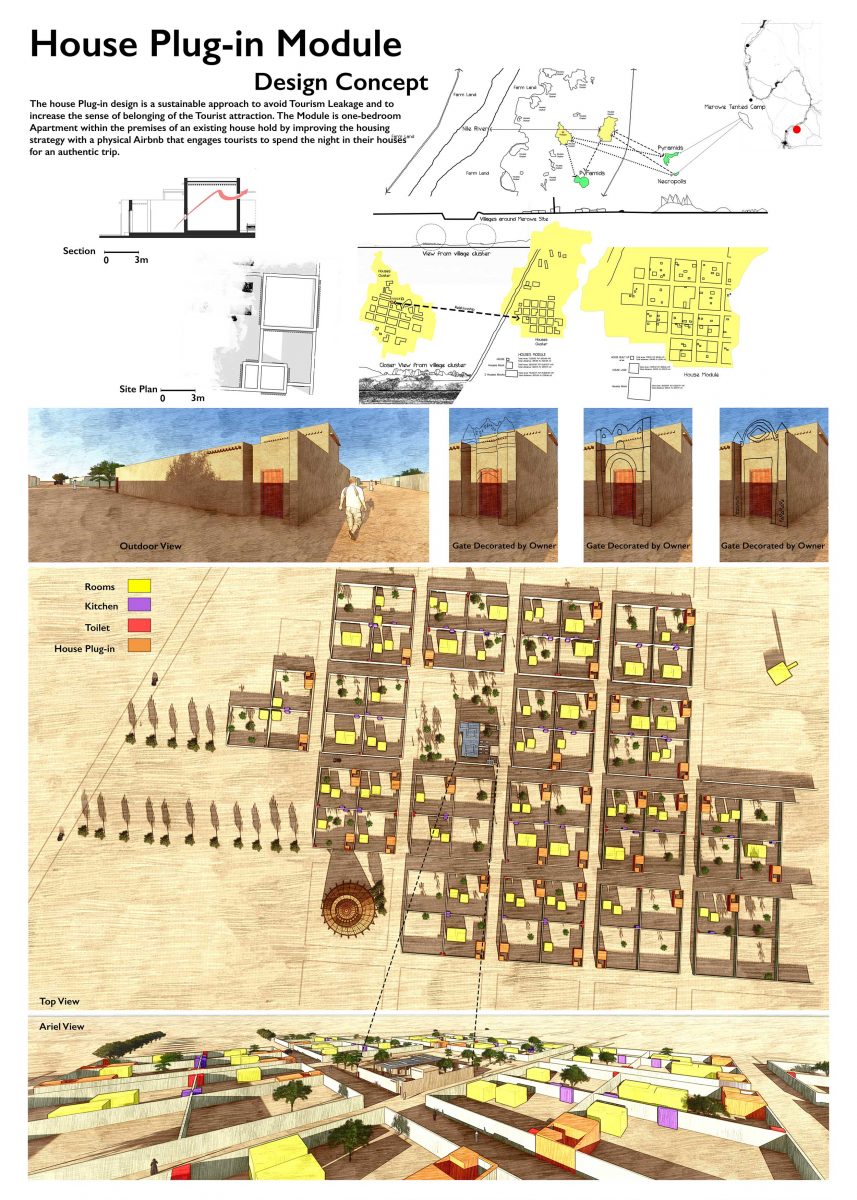The Kush trail is a virtual trail that connects the monuments related to the ancient African kingdom of Kush, that once existed. The Trail will be the new artistic hub where designers regenerate and reintroduce a new era of how history will affect our future. The idea began with identifying the monuments that can actually be introduced and linked through the Nile River. Thus, facilitating them with the utilities and activities a tourist can be interested in. The idea is to engage the villagers around the monuments in the activities, construction and profit from the arising tourism movement to mitigate the sense of belonging and to create a sustainable economic viability in the region.

Site Analysis 
Site Plan 
1. Nile Confluence Elevated Walkway Design 
2. House Plug-in Module 
3. Utilities Design Prototype 
4. Desert Tent Camp Design 
5. Amara West Restoration Design 
Amara West Monument Night View 
6. Amara Crafts Village Design
1.The Nile Confluence will be the first stop where tourists and residents explore the contemporary revolution monument, and get to enjoy the view of the nile river from the elevated walkway.
2. The house Plug-in design is a sustainable approach to avoid Tourism Leakage and to increase the sense of belonging of the Tourist attraction. The Module is one-bedroom Apartment within the premises of an existing household, and will act as an improvement of the housing strategy with a physical Airbnb that engages tourists to spend the night in their houses for an authentic trip.
3. The utilities design prototype is a modular design, that will be introduced within a 2-mile radius from the boundaries of the monument area to help the tourist to relax, rest, have a snack and observe the monument from a distinguish spacious distance . The design has two sizes which will be implemented based on the need of the specific monument location. It includes Male and female toilets+ reception that is provided with ticketing office and an upper floor that is serve as the observing and dinning space. The design is oriented North and depending on the specific location a rotating viewing frame will move to provide the specific view. The design is meant to spring from the earth. The ruins resemble the villagers personal influence and how they facilitate and maintain this building as part of a larger sustainable economy cycle.
4. The tent camp Design is inspired by the Bedouin tent camps and how to formulate their urban fabric by grouping tents. Those tent groups are radially scattered around a specific point. The original camp center point Is mainly the head of the family household but in this design, it’s the main gathering space for food and activities. The modular tent design is studied to optimized daylight, ventilation views and to optimize shade for the openings, that contains three narratives. The tents are raised on a platform to provide a cool air circulation that will then penetrate to the building envelope
5. Amara West Monument Restoration is the first or the last departure point tourist who are interested in the Kush kingdom will experience. It will depend on either they are coming from the previous monument stop in Kush Trail or they are outbounds from Egypt. The design of Monument restoration allows the tourist to engage in a fictional story that once existed and how our history shapes our reality of today. The canopy mesh has the minimum interaction with the monument’s ruins. it only touches the ground with steel members that are designed to carry the overall mesh load. Around the Monument there is a platform that carries the observer around the monument and make them engaged in overlooking the reflected traces that is projected from the roof.
6. Amara Crafts Village is designed to inspire the tourists that will be visiting Amara monument restoration project, to try the different craftsmanship that the villagers of Amara practice, and to be able to design their own souvenirs. The design is a simple Modular design which is 5*5*5 Meter that will allow adequate space to create craftsmanship and another small mezzanine for storage that is provided above 3-meter level and connected with ladder. All the workshops are elevated from gradually rising Sand dunes. The workshop sits on singular column that carries the platform which carries the walls and the roof that carries the space-frame shading on top.The village have 8 workshops: Metal, clay, jewelry, Painting and Drawing, Fashion, Music instruments, Sculpture and Ceramics





